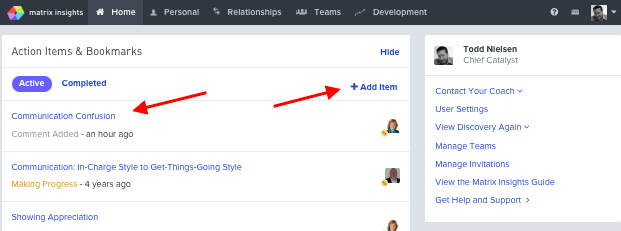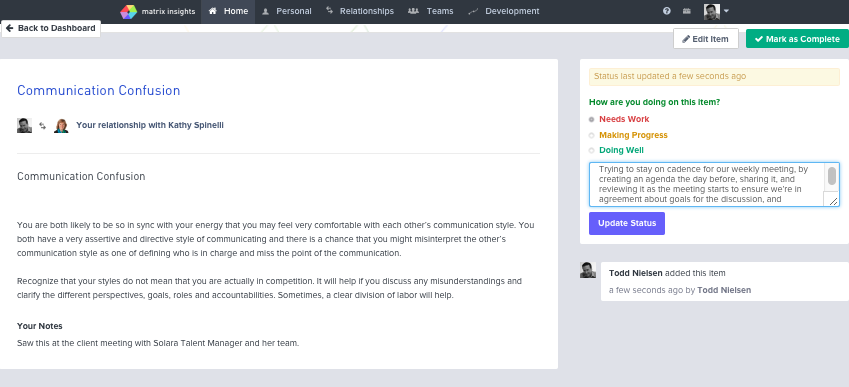Your Action Plan is a record of your developmental priorities. It’s like a To Do list for a Better You. Here’s how to create it, bring it to life, and put it to work.

You’ve been exposed to a variety of Insights about putting your new knowledge to work, and you should have added one or more items to your Action Plan. Here’s what comes next to reinforce the learning:
- Groom your Action Plan to self-assess your progress. For each item on your Action Plan, add a brief note about what, why, and how you practiced, or put this to work for you. See the example below for the Insight tip: “Communication Confusion.” For your Action items, be SMART in describing specific, measurable, attainable, goals tied to your improvement.
- Do this regularly. You might choose each Friday, or the First day of each month. The point is that you choose, and become methodical about thinking and acting to improve yourself. Then execute on what you decided, and keep to it for a period of time. You might choose three weeks, or three months. Whatever cadence and period of time that works for you, choose it, stick to it, make time for it, and be honest about your progress.
- Be honest with yourself about your progress, and record it. Choose as to each Action Item, whether you honestly feel your behavior as to this item: “Needs Work,” is “Making Progress,” or are “Doing Well.” Note that these three simple categories are colored Red, Yellow, and Green (like a traffic light) for a reason. Annotate why you chose with a brief statement or mini-journal entry. Where applicable, include your specific plans to improve. Click on “Update Status” to record and time stamp this event.

- Share at least one of your pending Action Items with an Accountability Partner. Accountability Partners are anyone you trust to help you improve. This can be a peer, mentor, coach or your manager. It might even be a trusted friend or family member you can talk with frankly about wanting to better yourself. The point of an Accountability Partner is that you identify a person with that in mind, advise them you’re working on improving yourself, and invite them to hold you accountable to work on improving yourself. Sharing your goals not only makes it more real and actionable, it creates a ‘social’ aspect which alters your relationship, and adds a new dimension to your dialogue with those Accountability Partners.
Combine all the steps above to better yourself. Making and maintaining Action Plans, recording progress against a SMART framework, then sharing your progress against those goal(s) with your Accountability Partner(s) are the ingredients to better performance at work, and in life.
Watch a tutorial on Action Planning.
Learn more about SMART goals.
Learn about the Nudge theory of behavioral science, generally situations where positive reinforcement (“nudges”) are used to improve the life and wellbeing of people and society.